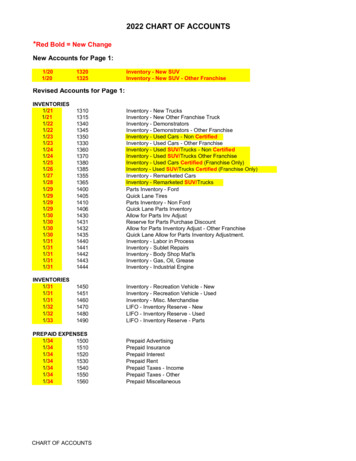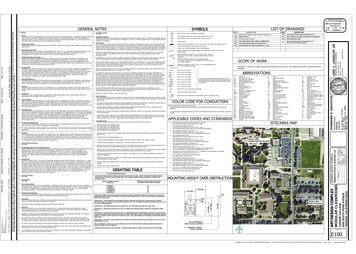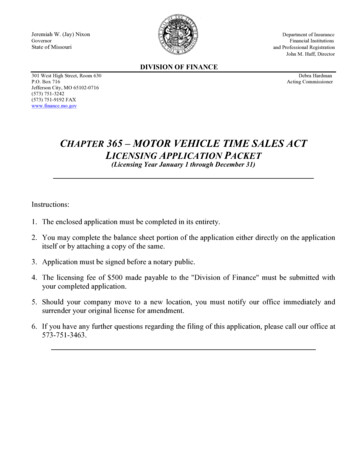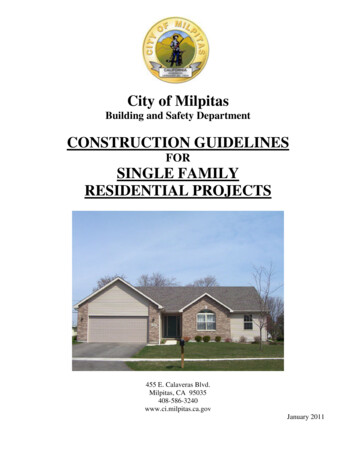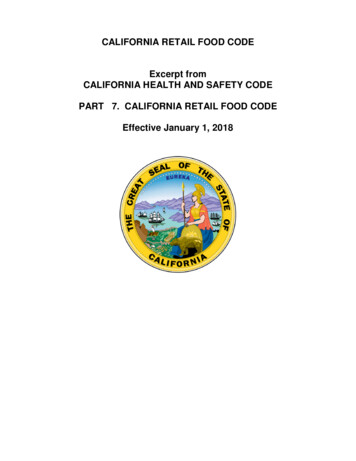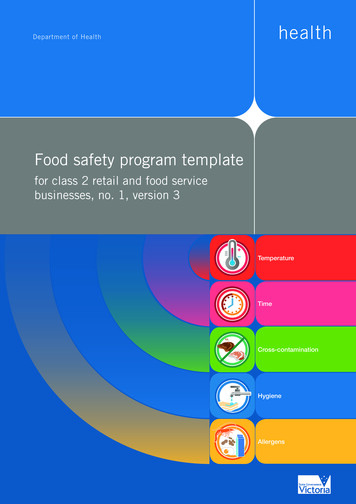
Transcription
CALIFORNIA RETAIL FOOD CODEExcerpt fromCALIFORNIA HEALTH AND SAFETY CODEDIVISION 104. ENVIRONMENTAL HEALTHPART 7. CALIFORNIA RETAIL FOOD CODEEffective January 1, 2019
California Retail Food CodeEffective January 1, 2019TABLE OF CONTENTSPAGECHAPTER 1. GENERAL PROVISIONS4CHAPTER 2. DEFINITIONS7CHAPTER 3. MANAGEMENT AND PERSONNELArticle 1 – SupervisionArticle 2 – Employee KnowledgeArticle 3 – Employee HealthArticle 4 – HandwashingArticle 5 – Personal CleanlinessArticle 6 – Hygienic Practices273234373737CHAPTER 4. GENERAL FOOD SAFETY REQUIREMENTSArticle 1 – Protection from ContaminationArticle 2 – Time Temperature RelationshipsArticle 3 – Food from Approved SourcesArticle 4 – Receipt of FoodArticle 5 – Food StorageArticle 6 – Specialized Processing MethodsArticle 7 – Food Display and ServiceArticle 8 – Consumer Information3641464750515357CHAPTER 5. CLEANING AND SANITIZING OF EQUIPMENTAND UTENSILS61CHAPTER 6. EQUIPMENT, UTENSILS, AND LINENSArticle 1 – Design and ConstructionArticle 2 – VentilationArticle 3 – Location and InstallationArticle 4 – Maintenance and OperationArticle 5 – Linens6871737576CHAPTER 7. WATER, PLUMBING, AND WASTEArticle 1 – WaterArticle 2 – Liquid WasteArticle 3 – Mobile Water and Wastewater TanksArticle 4 – Refuse77797982CHAPTER 8. PHYSICAL FACILITIESArticle 1 – Toilet FacilitiesArticle 2 – LightingArticle 3 – Poisonous and Toxic MaterialsArticle 4 – Employee Storage AreaArticle 5 – Premises and FacilitiesArticle 6 – Vermin and Animals8484858686862
California Retail Food CodeEffective January 1, 2019PAGECHAPTER 9. PERMANENT FOOD FACILITIESArticle 1 – Floors, Walls, and CeilingsArticle 2 – Toilet FacilitiesArticle 3 – Janitorial FacilitiesArticle 4 – PremisesArticle 5 – Prepackaged Nonpotentially Hazardous Food888990919292CHAPTER 10.93MOBILE FOOD FACILITIESCHAPTER 10.1. CATERING OPERATION AND HOST FACILITIES101CHAPTER 10.5. NONPROFIT CHARITABLE TEMPORARYFOOD FACILITIES104CHAPTER 10.6. LIMITED SERVCIE CHARITABLE FEEDING OPERATION105CHAPTER 11.107TEMPORARY FOOD FACILITIESCHAPTER 11.5. COTTAGE FOOD OPERATIONS110CHAPTER 11.6. MICROENTERPRISE HOME KITCHEN OPERATION114CHAPTER 12.120CERTIFIED FARMERS’ MARKETSCHAPTER 12.5 FARM STANDS AND COMMUNITY FOOD PRODUCTION122CHAPTER 12.7. FISHERMEN’S MARKETS124CHAPTER 12.8 CHILDREN’S MEALS127CHAPTER 13. COMPLIANCE AND ENFORCEMENTArticle 1 – Plan Review and PermitsArticle 2 – EnforcementArticle 3 – Permit Suspension and RevocationArticle 4 – VarianceArticle 5 – HACCP ExemptionsArticle 6 – ExemptionsArticle 7 – Food Facility Food DonationsArticle 8 – Child Day Care Facilities, Community CareFacilities and Residential Care Facilities for the Elderly1281301311321341361381393
California Retail Food CodeEffective January 1, 2019CHAPTER 1. General Provisions113700. These provisions shall be known, and may be cited, as the California Retail FoodCode, hereafter referred to as “this part.”113703. The purpose of this part is to safeguard public health and provide to consumers foodthat is safe, unadulterated, and honestly presented through adoption of science-basedstandards.113705. The Legislature finds and declares that the public health interest requires that there beuniform statewide health and sanitation standards for retail food facilities to assure the peopleof this state that the food will be pure, safe, and unadulterated. Except as provided in Section113709, it is the intent of the Legislature to occupy the whole field of health and sanitationstandards for retail food facilities, and the standards set forth in this part and regulationsadopted pursuant to this part shall be exclusive of all local health and sanitation standardsrelating to retail food facilities.113707. The department shall adopt regulations to implement and administer this part.113709. This part does not prohibit a local governing body from adopting an evaluation orgrading system for food facilities, from prohibiting any type of food facility, from adopting anemployee health certification program, from regulating the provision of consumer toilet andhandwashing facilities, from adopting requirements for the public safety regulating the type ofvending and the time, place, and manner of vending from vehicles upon a street pursuant to itsauthority under subdivision (b) of Section 22455 of the Vehicle Code, or from prohibiting thepresence of pet dogs in outdoor dining areas of food facilities.113711. In all laws and regulations, references to Chapter 4 (commencing with Section113700) or the California Uniform Retail Food Facilities Law, shall mean this part or theCalifornia Retail Food Code.113713.(a) Primary responsibility for enforcement of this part shall be with the local enforcementagency. Nothing in this part shall prevent the department from taking any necessary programor enforcement actions for the protection of the public health and safety.(b) The department shall provide technical assistance, training, standardization, programevaluation, and other services to local health agencies as necessary to ensure the uniforminterpretation and application of this part, when an appropriation is made to the department forthis purpose.(c) Whenever the enforcement of the requirements of this part by any local enforcementagency is satisfactory to the department, the enforcement of this part shall not be duplicated bythe department. The department shall investigate to determine satisfactory enforcement of thispart by evaluating the program of each local enforcement agency at least once every threeyears and shall prepare a report of the evaluation and list any program improvements neededonly when an appropriation is made to the department for these purposes.113715. Any construction, alteration, remodeling, or operation of a food facility shall beapproved by the enforcement agency and shall be in accordance with all applicable local,state, and federal statutes, regulations, and ordinances, including but not limited to, fire,building, and zoning codes.4
California Retail Food CodeEffective January 1, 2019113717.(a) Any person requesting the department to undertake any activity pursuant to paragraph (5)of subdivision (c) of Section 113871, Section 114417, paragraph (2) of subdivision (b) ofSection 114419, and Section 114419.3 shall pay the department’s costs incurred inundertaking the activity. The department’s services shall be assessed at the current hourlycost-recovery rate, and it shall be entitled to recover any other costs reasonably and actuallyincurred in performing those activities, including, but not limited to, the costs of additionalinspection and laboratory testing. For purposes of this section, the department’s hourly rateshall be adjusted annually in accordance with Section 100425.(b) The department shall provide to the person paying the required fee a statement, invoice, orsimilar document that describes in reasonable detail the costs paid.(c) For purposes of this section only, the term “person” does not include any city, county, cityand county, or other political subdivision of the state or local government.113718. Notwithstanding Section 16350 of the Government Code, all moneys deposited in theRetail Food Safety and Defense Fund shall be transferred to the Food Safety Fund forappropriation and expenditure as specified by Section 110050.113719. Structural and sanitation requirements shall be based on the food service activity to beconducted, the type of food that is to be prepared or served, and the extent of food preparationthat is to be conducted at the food facility.113725.(a) The enforcement agency shall utilize a standardized food facility inspection format for foodfacility inspections that includes all of the following:(1) The name and address of the food facility.(2) Identification of the following inspection criteria, which shall be the basis of the inspectionreport:(A) Improper holding temperatures of potentially hazardous foods.(B) Improper cooling of potentially hazardous foods.(C) Inadequate cooking of potentially hazardous foods.(D) Poor personal hygiene of food employees.(E) Contaminated equipment.(F) Food from unapproved sources.(3) For each violation identified pursuant to paragraph (2), classification of the violation as aminor violation or major violation.(b) An enforcement agency may modify the format to add criteria to those specified pursuant toparagraph (2) of subdivision (a), if both of the following conditions are met:(1) The additional criteria are based on other provisions of this part.(2) A violation is identified by reference to items and sections of this part, or the regulationsadopted pursuant to this part relating to those items, if a food facility is cited for a violation ofthe additional criteria.(c) This section shall not restrict the ability of the enforcement agency to inspect and report oncriteria other than those subject to regulation under this part.5
California Retail Food CodeEffective January 1, 2019113725.1. A copy of the most recent routine inspection report conducted to assess compliancewith this part shall be maintained at the food facility and made available upon request. Thefood facility shall post a notice advising consumers that a copy of the most recent routineinspection report is available for review by any interested party.113725.2. Local enforcement agencies, and the department when adequate funding is madeavailable to the department, shall conduct routine training on food facility inspectionstandardization to promote the uniform application of inspection procedures.113725.3.(a) The department shall publish standardized procedures for enforcement agencies to reportfood facility inspection information regarding each food facility. The report shall include all ofthe following:(1) Name and address of the food facility.(2) Date of last inspection.(3) Identification of any major violation identified in a food facility inspection.(4) Reinspection date, if applicable.(5) Period of closure, if applicable.(b) The department, in consultation with local environmental health directors, representatives ofthe retail food industry, and other interested parties, may periodically review and revise thestandardized procedures established pursuant to subdivision (a). In making any revisions, thedepartment shall strive to ensure that the required information can be reported and madeavailable in the most efficient, timely, and cost-effective manner.(c)(1) The standardized procedures established pursuant to this section shall include astandardized electronic format and protocol for reporting the food facility inspection data in atimely manner, and shall strive to ensure that the information is readily accessible, can berapidly reported, and, if necessary, corrected, for each food facility that has been inspected orreinspected. If the enforcement agency determines that reported information is materially inerror, that error shall be corrected within 48 hours after that determination.(2) The department may establish standardized procedures for reporting the information onelectronic media, including, but not limited to, floppy disks or compact disks.(d) Within 60 days after the department has established the standardized procedures pursuantto this section, the department shall publish these procedures.(e)(1) Each enforcement agency that reports food facility inspection information on an InternetWeb site shall report the information in accordance with the standardized proceduresestablished pursuant to this section.(2) This section shall not restrict the ability of an enforcement agency to report on mattersother than matters subject to regulation under this part.(f) The department may establish a link to each Internet Web site utilized by any enforcementagency containing the food facility inspection information pursuant to subdivision (e).6
California Retail Food CodeEffective January 1, 2019CHAPTER 2. Definitions113728. The following definitions apply in the interpretation and application of this part.113729. “Food additive” has the meaning stated in Section 109940. “Color additive” has themeaning stated in Section 109895.113729.5. “Acceptable market name” means a name that the FDA recognizes as a suitablestatement of identity, as described in Section 101.3 of Title 21 of the Code of FederalRegulations, in the labeling of a species. An acceptable market name fairly represents theidentity of the species to United States consumers because it is not confusingly similar to thename of another species and because it is not otherwise misleading. An acceptable marketname may be any of the following:(a) A common or usual name established by either a history of common usage in the UnitedStates or by regulation.(b) The common name.(c) A name specifically coined as the market name for a species. For example, “basa” is themarket name coined for Pangasius bocourti.113732. “Adulterated” means either of the following:(a) Food that bears or contains any poisonous or deleterious substance that may render thefood impure or injurious to health.(b) Food that is manufactured, prepared, or stored in a manner that deviates from a HACCPplan so as to pose a discernable increase in risk.113733. “Acute gastrointestinal illness” means a short duration illness most often characterizedby either of the following, which are known to be commonly associated with the agents mostlikely to be transmitted from infected food employees through contamination of food:(a) Diarrhea, either alone or in conjunction with other gastrointestinal symptoms, such asvomiting, fever, or abdominal cramps.(b) Vomiting in conjunction with either diarrhea or two other gastrointestinal symptoms, such asfever or abdominal cramps.113734. “Approved” means acceptable to the enforcement agency based on a determination ofconformity with applicable laws, or, in the absence of applicable laws, current public healthprinciples, practices, and generally recognized industry standards that protect public health.113735.(a) “Approved source” means a food source allowed under Article 3 (commencing with Section114021) of Chapter 4, or a producer, manufacturer, distributor, or food facility that is acceptableto the enforcement agency based on a determination of conformity with applicable laws, or, inthe absence of applicable laws, with current public health principles and practices, andgenerally recognized industry standards that protect public health.(b) Any whole uncut fruit or vegetable or unrefrigerated shell egg grown or produced incompliance with all applicable federal, state, or local laws, regulations, and food safetyguidelines issued by a regulatory agency shall be deemed to be from an approved source.7
California Retail Food CodeEffective January 1, 2019113737. “aw” means water activity that is a measure of the free moisture in a food, is thequotient of the water vapor pressure of the substance divided by the vapor pressure of purewater at the same temperature, and is indicated by the symbol aw.113739. “Beverage” means a liquid for drinking, including water.113739.1.(a) “Catering operation” means a food service that is conducted by a permanent food facilityapproved for food preparation where food is served, or limited food preparation is conducted,at a location other than its permitted location, in either of the following circumstances:(1) As part of a contracted offsite food service event.(2) When operating in conjunction with a host facility with direct food sales.(b) “Catering operation” shall not include either of the following:(1) Food ordered as takeout or delivery from a food facility, where the food is provided to theconsumer for self-service.(2) A food facility that is participating as part of a community event.113740. “CCR” means the California Code of Regulations.113742. “Certified farmers’ market” means a location that is certified by the State of Californiathrough the enforcement officers of the county agricultural commissioners and operatedpursuant to Chapter 10.5 (commencing with Section 47000) of Division 17 of the Food andAgricultural Code and regulations adopted pursuant to that chapter.113744. “C.F.R.” means the Code of Federal Regulations. Citations in this part to the C.F.R.refer sequentially to the title, part, and section numbers, such as 21 C.F.R. 178.1010 refers toTitle 21, Part 178, Section 1010.113747.(a) “CIP” means cleaned in place by the circulation or flowing by mechanical means through apiping system of a detergent solution, water rinse, and sanitizing solution onto or overequipment surfaces that require cleaning, such as the method used, in part, to clean andsanitize a frozen dessert machine.(b) “CIP” does not include the cleaning of equipment such as band saws, slicers, or mixers thatare subjected to in-place manual cleaning without the use of a CIP system.113747.1. “Cold water” means potable water that is not heated by an auxiliary method orsource.113748. “Commingle” means:(a) To combine shellstock harvested on different days or from different growing areas asidentified on the tag or label.(b) To combine shucked shellfish from containers with different container codes or differentshucking dates.113750.(a) “Comminuted” means reduced in size by methods including chopping, flaking, grinding, ormincing.(b) “Comminuted” includes fish or meat products that are reduced in size and restructured orreformulated including, but not limited to, gefilte fish, formed roast beef, gyros, ground beef,8
California Retail Food CodeEffective January 1, 2019sausage, and a mixture of two or more types of meat that have been reduced in size andcombined, including, but not limited to, sausages made from two or more meats.113751. “Commissary” means a food facility that services mobile food facilities, mobile supportunits, or vending machines where any of the following occur:(a) Food, containers, or supplies are stored.(b) Food is prepared or prepackaged for sale or service at other locations.(c) Utensils are cleaned.(d) Liquid and solid wastes are disposed, or potable water is obtained.113752. “Community food producer” means a producer of agricultural products on land that isnot zoned for agricultural use but is otherwise in compliance with applicable local land use andzoning restrictions, including, but not limited to, restrictions governing personal gardens,community gardens, school gardens, and culinary gardens.113755. “Community event” means an event conducted for not more than 25 consecutive ornonconsecutive days in a 90-day period and that is of a civic, political, public, or educationalnature, including state and county fairs, city festivals, circuses, and other public gatheringevents approved by the local enforcement agency.113756. “Condiment” means a nonpotentially hazardous food, such as relishes, spices,sauces, confections, or seasonings, that requires no additional preparation, and that is used ona food item, including, but not limited to, ketchup, mustard, mayonnaise, sauerkraut, salsa, salt,sugar, pepper, or chile pepper.113757. “Consumer” means a person who is a member of the public, takes possession offood, is not functioning in the capacity of an operator of a food facility, and does not offer thefood for resale.113758.(a) “Cottage food operation” means an enterprise that has not more than the amount in grossannual sales that is specified in this subdivision, is operated by a cottage food operator, andhas not more than one full-time equivalent cottage food employee, not including a familymember or household member of the cottage food operator, within the registered or permittedarea of a private home where the cottage food operator resides and where cottage foodproducts are prepared or packaged for direct, indirect, or direct and indirect sale to consumerspursuant to this part. In 2013, the enterprise shall not have more than thirty-five thousand dollar( 35,000) in gross annual sales in the calendar year. In 2014, the enterprise shall not havemore than forty-five thousand dollars ( 45,000) in gross annual sales in the calendar year.Commencing in 2015, and each subsequent year thereafter, the enterprise shall not have morethan fifty thousand dollars ( 50,000) in gross annual sales in the calendar year. A cottage foodoperation includes both of the following:(1) A “Class A” cottage food operation, which is a cottage food operation that may engageonly in direct sales of cottage food products from the cottage food operation or other directsales venues described in paragraph (4) of subdivision (b).(2) A “Class B” cottage food operation, which is a cottage food operation that may engage inboth direct sales and indirect sales of cottage food products from the cottage food operation,from direct sales venues described in paragraph (4) of subdivision (b), from offsite events, orfrom a third-party retail food facility described in paragraph (5) of subdivision (b).(b) For purposes of this section, the following definitions shall apply:9
California Retail Food CodeEffective January 1, 2019(1) “Cottage food employee” means an individual, paid or volunteer, who is involved in thepreparation, packaging, handling, and storage of a cottage food product, or otherwise worksfor the cottage food operation. An employee does not include an immediate family member orhousehold member of the cottage food operator.(2) “Cottage food operator” means an individual who operates a cottage food operation in hisor her private home and is the owner of the cottage food operation.(3) “Cottage food products” means nonpotentially hazardous foods, including foods that aredescribed in Section 114365.5 and that are prepared for sale in the kitchen of a cottage foodoperation.(4) “Direct sale” means a transaction within the state between a cottage food operationoperator and a consumer, where the consumer purchases the cottage food product directlyfrom the cottage food operation. Direct sales include, but are not limited to, transactions atholiday bazaars or other temporary events, such as bake sales or food swaps, transactionsat farm stands, certified farmers’ markets, or through community-supported agriculturesubscriptions, and transactions occurring in person in the cottage food operation.(5) “Indirect sale” means an interaction between a cottage food operation, a third-partyretailer, and a consumer, where the consumer purchases cottage food products made by thecottage food operation from a third-party retailer that holds a valid permit issued pursuant toSection 114381. Indirect sales include, but are not limited to, sales made to retail shops or toretail food facilities where food may be immediately consumed on the premises.(6) “Private home” means a dwelling, including an apartment or other leased space, whereindividuals reside.(7) “Registered or permitted area” means the portion of a private home that contains theprivate home’s kitchen used for the preparation, packaging, storage, or handling of cottagefood products and related ingredients or equipment, or both, and attached rooms within thehome that are used exclusively for storage.113759. “Control point” means any distinct procedure or step in receiving, storing, handling,preparing, displaying, transporting, or dispensing a food.113760. “Critical control point” means a point or procedure in a specific food system where lossof control may result in an unacceptable health risk.113761. “Critical limit” means the maximum or minimum value to which a physical, biological,or chemical parameter must be controlled at a critical control point to minimize the risk that theidentified food safety hazard may occur.113763. “Department” means the State Department of Public Health.113767. “Easily cleanable” means a characteristic of a surface that allows effective removal ofsoil, food residue, or other organic or inorganic materials by normal cleaning methods.113768. “Easily movable” means either of the following:(a) Portable; mounted on casters, gliders, or rollers so as to be moveable by one person; orprovided with a mechanical means to safely tilt or move a unit of equipment for cleaning.(b) Having no utility connection, a utility connection that disconnects quickly, or a flexible utilityconnection line of sufficient length to allow the equipment to be moved for cleaning of theequipment and adjacent area.10
California Retail Food CodeEffective January 1, 2019113769. “Egg” means the shell egg of an avian species that includes chicken, duck, goose,guinea, quail, ratite, or turkey, except a balut and an egg product. “Egg” does not include theegg of a reptile species, including an alligator.113770. “Employee” means the permitholder, person in charge, person having supervisory ormanagement duties, person on the payroll, family member, volunteer, person performing workunder contractual agreement, or other person working in a food facility.113773. “Enforcement agency” means the department or the local health agency havingjurisdiction over the food facility.113774. “Enforcement officer” means the director, agents, or environmental health specialistsappointed by the State Public Health Officer, and all local health officers, directors ofenvironmental health, and their duly authorized registered environmental health specialists andenvironmental health specialist trainees.113777.(a) “Equipment” means an article that is used in the operation of a food facility, including, butnot limited to, a freezer, grinder, hood, icemaker, meat block, mixer, oven, reach-in refrigerator,scale, food and utensil shelving and cabinets, sink, slicer, stove, table, temperature measuringdevice for ambient air, vending machine, or warewashing machine.(b) “Equipment” does not include items used for handling or storing large quantities ofprepackaged foods that are received from a supplier in a cased or overwrapped lot, such ashand trucks, forklifts, dollies, pallets, racks, and skids.113778. “Exclude” means to prevent a person from working as a food employee or entering afood facility except for those areas open to the general public.113778.1. “FDA” means the United States Food and Drug Administration.113778.2. “Farm stands” are premises, established in accordance with local ordinances andland use codes, defined under and operated pursuant to Chapter 10.5 (commencing withSection 47000) of Division 17 of the Food and Agricultural Code and regulations adopted andenforced pursuant to that chapter, operating within the requirements set forth in Sections113789 and 114375.113778.4. “Fabric implement” means a cloth or fabric, including, but not limited to, burlap andcheesecloth, that is used as part of the food process and comes in direct contact with food thatis subsequently cooked.113779.(a) “Fish” means fresh or saltwater finfish, crustaceans, and other forms of aquatic life, otherthan birds or mammals, and all molluscan shellfish, if intended for human consumption. “Fish”also includes alligator, frog, aquatic turtle, jellyfish, sea cucumber, and sea urchin, and the roeof these animals.(b) “Fish” includes a product derived in whole or in part from fish, including fish that have beenprocessed in any manner.113780. “Fishermen’s market” means a location that is operated by a commercial fishermanlicensed by the Department of Fish and Wildlife or an entity representing two or moreCalifornia-licensed commercial fishermen or California-licensed commercial fishermen andCalifornia-registered aquaculturists, that sells only raw edible aquatic plants, raw fresh fish, orfresh frozen fish, caught by commercial fishermen licensed by the Department of Fish andWildlife or harvested by California-registered aquaculturists, directly to consumers.11
California Retail Food CodeEffective January 1, 2019113781. “Food” means a raw, cooked, or processed edible substance, ice, beverage, aningredient used or intended for use or for sale in whole or in part for human consumption, andchewing gum.113783. “Food bank” means a surplus food collection and distribution system operated andestablished to assist in bringing donated food to nonprofit charitable organizations andindividuals for the purposes of reducing hunger and supplying nutritional needs.113784. “Food compartment” means an enclosed space, including, but not limited to, an airpot, blender, bulk dispensing system, covered chafing dish, and covered ice bin, with all of thefollowing characteristics:(a) The space is defined by a physical barrier from the outside environment that completelyencloses all food, food-contact surfaces, and the handling of nonprepackaged food.(b) All access openings are equipped with tight-fitting closures, or one or more alternativebarriers that effectively protect the food from contamination, facilitate safe food handling, whileminimizing exposure to the environment.(c) It is constructed from materials that are nontoxic, smooth, easily cleanable, and durable andis constructed to facilitate the cleaning of the interior and exterior of the compartment.113786. “Food-contact surface” means either of the following:(a) A surface of equipment or a utensil with which food normally comes into contact.(b) A surface of equipment or a utensil from which food may drain, drip, or splash into a food oronto a surface normally in contact with food.113788. “Food employee” means an employee working with food, food equipment or utensils,or food-contact surfaces.113789.(a) “Food facility” means an operation that stores, prepares, packages, serves, vends, orotherwise provides food for human consumption at the retail level, including, but not limited to,the following:(1) An operation where food is consumed on or off the premises, regardless of whether thereis a charge for the food.(2) A place used in conjunction with the operations described in this subdivision, including,but not limited to, storage facilities for food-related utensils, equipment, and materials.(b) “Food facility” includes permanent and nonpermanent food facilities, including, but notlimited to, the following:(
Article 3 - Mobile Water and Wastewater Tanks 79 Article 4 - Refuse 82 . CHAPTER 8. PHYSICAL FACILITIES . Article 1 - Toilet Facilities 84 Article 2 - Lighting 84 Article 3 - Poisonous and Toxic Materials 85 Article 4 - Employee Storage Area 86 Article 5 - Premises and Facilities 86 Article 6 - Vermin and Animals 86
